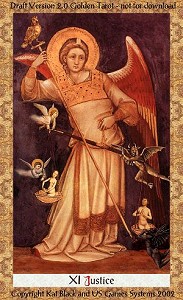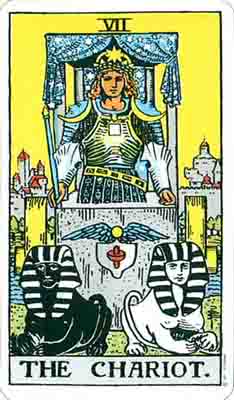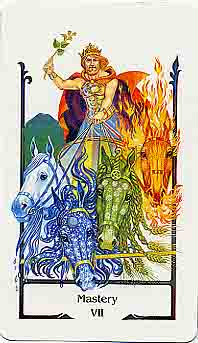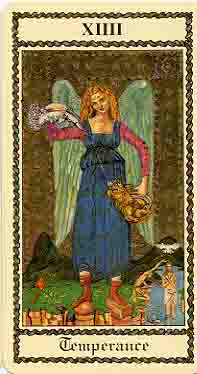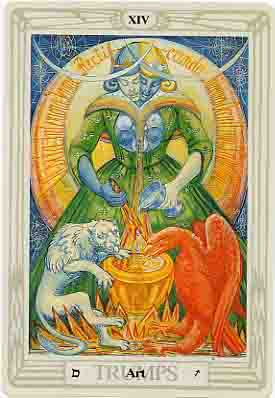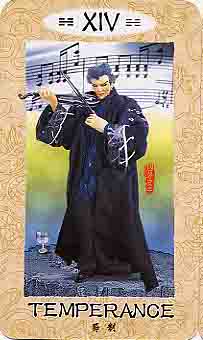Inner Peace: How Tarot Can Point the Way
Posted by Jeannette Roth on Jun 9th 2018
Preface: One of the things that has fascinated me about tarot since I first began my studies is how completely different cards can examine the same concept from different angles, thereby presenting a sort of "three dimensional image for the soul" of that concept. Like my earlier post on the evolution of tarot, this essay was originally published in the eZine Timeless Spirit. It explores the topic of psychological and spiritual balance (one of my absolute favorite tarot subjects) from the point-of-view of three separate major arcana. Originally published in 2004, I am pleased to be able to share it again here with our Tarot Garden visitors.
Inner Peace: How Tarot Can Point the Way
The world is a complicated place. Stress has become an acknowledged, even accepted, part of our daily lives. Our obligations are many; if we are fortunate, so are our options. Yet even freedom of choice presents its own dilemmas – how does one select among so many alternatives? To choose one road means we must forgo others...
Is it any wonder, then, that we often fail so miserably when we seek to eliminate the causes of stress in our lives? The wisdom of our age exhorts us to seek "inner peace." Yet how can we hope to achieve this when our "outer lives" are so complex?
The "stock answer" to this question comes from Eastern philosophy, and can usually be stated in one word: simplify. When life is less complicated, one can be more at peace. It is a logical and profound response to a perplexing question. And yet, is it a realistic one?
In her classic text, The Mystical Qabbalah, Dion Fortune provides some insightful commentary about the application of Eastern philosophy to every individual situation. She wisely takes cultural context into account when she writes:
It is injudicious to apply to one type of psycho-physical make-up the developing methods adapted to another; they will either fail to produce adequate results, or produce unforeseen and possibly undesirable results. To say this is not to condemn the Eastern methods, nor decry the Western constitution, which is as God made it, but to reaffirm the old adage that one man's meat is another man's poison.
The dharma of the West differs from that of the East; is it therefore desirable to try and implant Eastern ideals in a Westerner? Withdrawal from the earth-plane is not his line of progress. The normal, healthy Westerner has no desire to escape from life, his urge is to conquer it and reduce it to order and harmony. It is only the pathological types who long to "cease upon the midnight with no pain," to be free from the wheel of birth and death; the normal Western temperament demands "life, more life."
But if we accept that the Western zeitgeist predisposes many of us to embrace the opportunities of the physical world, then what other resources can we employ to bring some increased measure of peace into our lives? If we consult the tarot to find the answer to this question, either through reading or meditation, what should we be looking for?
The "Western" Alternative
While it may not be ideal to pare down our lives to the focused minimalism of an ascetic monk, it is equally clear that neither is it possible to "do it all." Wise choices must be made if we hope to experience a heightened level of serenity in our day-to-day existence.
The key to making these choices lies in the concept of balance. Perhaps we cannot have it all, but we should succeed in making the most of what we can have if we are able to establish and maintain an equilibrium among our obligations and aspirations.
Tarot has a great deal to say on the subject of balance. And while representations of this theme abound within tarot's 78 images, we can gain a great deal of insight rather quickly by focusing on a few of the more obvious examples. In this essay, I will examine a triad of cards, which together can help to shed some light on the process.
Making It Clear
We begin with Justice. Accompanied by her ever-present scales, she may seem a cliché, even superficial, representation of the “balance” concept. Yet not all truths need be veiled in mystery and obscurity. The trick is in recognizing their proper application.
The Justice card is often associated with the larger concept of Karma – that is, we “reap what we sow.” Our actions, for good or ill, are eventually returned upon us in equal measure. But as the Hermetic Axiom reminds us: “As above, so below.” Large “cosmic truths” are reflected in our day-to-day lives, albeit on a smaller scale.
Thus, the life that is “out of balance” is destined for difficulty, as Justice attempts to restore equilibrium through her natural and incontrovertible processes. To draw a broad example: if we place too much emphasis on our personal pursuits, and not enough on professional ones, our work suffers, and we may soon find ourselves lacking the necessary income to continue in our personal projects. Conversely, if we allow our professional activities to dominate, the lack of “personal time” can lead to stagnation, depression, and other ill effects which in turn ultimately undermine our careers, despite our best efforts in that arena.
 The preceding may seem obvious; the solution, less so. Once we have identified the problem, how do we rebalance the scales?
Justice herself provides part of the answer. The sword she holds is the key. In Aleister Crowley's Thoth tarot, as well as in several other decks, Justice's blade is specifically the Ace of Swords. This clearly shows us that the process is an intellectual one. There is no watery “cup” symbolism here; our emotions should be kept in check as we weigh the alternatives and analyze the results.In an interesting variation, some decks depict
Justice holding a staff rather than a sword. Although unusual, this alternative brings up an important point: like the fiery suit of Wands, Justice's actions are dynamic and ever-changing. We must not forget that what brings balance today may not, as new factors are introduced, continue in balance into the future. Crowley underscores this need to be alert and flexible in his retitling of the Justice card, which he calls Adjustment. Once again, however, it is our ability to review these changes intellectually that provides us with the means to respond and adapt when needed. We can see this represented symbolically in Kat Black's popular Golden Tarot. In Black's deck, the staff held by the avatar of Justice is topped with a gilt owl, signifying knowledge. We must use what we know to navigate the ever-changing unknown.
The preceding may seem obvious; the solution, less so. Once we have identified the problem, how do we rebalance the scales?
Justice herself provides part of the answer. The sword she holds is the key. In Aleister Crowley's Thoth tarot, as well as in several other decks, Justice's blade is specifically the Ace of Swords. This clearly shows us that the process is an intellectual one. There is no watery “cup” symbolism here; our emotions should be kept in check as we weigh the alternatives and analyze the results.In an interesting variation, some decks depict
Justice holding a staff rather than a sword. Although unusual, this alternative brings up an important point: like the fiery suit of Wands, Justice's actions are dynamic and ever-changing. We must not forget that what brings balance today may not, as new factors are introduced, continue in balance into the future. Crowley underscores this need to be alert and flexible in his retitling of the Justice card, which he calls Adjustment. Once again, however, it is our ability to review these changes intellectually that provides us with the means to respond and adapt when needed. We can see this represented symbolically in Kat Black's popular Golden Tarot. In Black's deck, the staff held by the avatar of Justice is topped with a gilt owl, signifying knowledge. We must use what we know to navigate the ever-changing unknown.
In meditation, we can imagine ourselves placing our various activities and obligations in Justice's scale pans, and watching the results. In a reading, we can look at surrounding cards for clues to which factors may be contributing to an imbalance, and how those factors might be adjusted to bring things back into harmony.
Making It Happen
The next stop on our tour of tarot's “balance” theme is less obvious than the first. It is one thing to identify what changes we need to make to bring about equilibrium, but it may be quite another to actually undertake steps to implement those plans. Now we look to a card that can provide some guidance in this second stage: The Chariot.
The Chariot shows us a figure who has brought opposing forces under control. In the classic Rider-Waite deck, we see that the sphinxes that draw The Chariot are complete opposites – one is white where the other is black, and vice versa. And although they even face in opposite directions, the Charioteer has succeeded in unifying their energies. Indeed, an interesting aspect of the Rider-Waite Chariot card, and many that have followed, is that the vehicle is not even in motion. The opposing forces are tamed, and at rest (“in balance”) for the moment.
Just as Justice has her sword, so does the Charioteer have his tool for accomplishing his task. He holds a wand in his right hand, signifying that he achieves his results through action. The time for Justice'sthoughtful analysis has passed. The Charioteer uses his skills to initiate and mediate plans made, to ensure their successful implementation.
For a slightly different approach to The Chariot's role, we can study the Tarot of the Old Path by Howard Rodway and Sylvia Gainsford. In Rodway and Gainsford's card (retitled “Mastery” – an appropriate alternative designation), we see the Charioteer holding the reins of four horses, drawn to represent the diverse energies of the four elements. Here, The Chariot is in motion, but the Charioteer nonetheless has things clearly under control. The reins for each horse match the beast's own color – implying that part of the secret for keeping the team “in balance” lies in using the right tool (or approach) for each job. His wand is a hazel sprig – held like a whip, yet a gentle, rather than violent, instrument for guiding the team toward their common destination. While the task of maintaining control is challenging, it is still a “light touch” that works best.
When meditating on The Chariot, we can explore what resources and techniques are needed to keep our “opposing elements” in check and, if appropriate, moving forward. If The Chariot appears in a reading, it can be a sign that it is time to stop debating and planning, and start acting. Surrounding cards may provide further information about how to “rein in” and direct the process so as to maintain the desired delicate balance.
Making It Work
Once we have identified how to restore balance in our lives, and taken steps to bring about the necessary changes, we are ready for the final phase: integration. In order to truly achieve an inner peace, we must do more than simply “go through the motions” of balancing one thing against another. We must make the results of the process a part of ourselves. The outcome must be natural and harmonious. If it is not, we may not be much better off than we were before we began.
To gain a better understanding of the integration process in this context, we look to the Temperance card. An excellent example for purposes of the current discussion can be found in Luigi Scapini's Medieval Scapini Tarot. The angel of Temperance, with the golden vessel of the sun in one hand and the silver vessel of the moon in the other, demonstrates the fluidic interplay between these two opposite yet balanced elements. Although the vessels themselves remain separate, each takes a piece of the other, allowing them to coexist in harmony.
In contrast to the airy, cerebral sword of Justiceand the fiery, dynamic wand of The Chariot, the work of Temperance takes place in the watery, intuitive world of cups. Here, we must take care not to over-intellectualize things. Now it is time to trust our feelings. Crowley underscores this idea in his own Thoth tarot, renaming his version of the card “Art” in order to clarify the true nature of this process. If the results do not “feel” right, it may be time to back up and consult Justice's scales once again, or to adjust the direction of The Chariot.
For another view of how balanced elements are integrated by Temperance's energies, we can examine the fascinating Taiwanese import, The Tarot of Pili. Here, the angel and her cups are replaced by a virtuoso violinist, practicing his craft. The image is profoundly apt. A musician must bring many skills to his performance – from an understanding of what the composer intended, to a knowledge of notes and rhythms and dynamics and tempos, to the mechanics of working the instrument to produce the proper sounds. But individually, these abilities add up to nothing – even in the “proper amounts.” Only when the musician is able to intuitively grasp how all these elements “fit together” can he truly produce music that will move and inspire the listener.
Meditating on the Temperance card can reveal how we honestly feel about the results of our efforts. Does our mixture flow effortlessly from cup to cup, or do we struggle unsuccessfully to achieve the desired blend? When Temperance appears in a reading, we can examine its position, orientation, or dignity to determine whether we will succeed in striking a agreeable balance in the long term, or if perhaps a wiser, more “natural” approach should be considered.
Conclusion
The concept of balance is reflected in many other ways throughout the tarot. In the minor arcana, for example, we can look to the Twos to learn more about the dynamics of opposing forces, while the Threes can suggest ways in which we can stabilize these opposites. But as we begin our journey toward inner peace by seeking balance in our lives, the archetypal trio of Justice (Analysis), The Chariot (Action), and Temperance (Integration) can point the way, and provide us with a solid foundation for future improvement and growth. If we are ready, the door is open...
...Or, in the perceptive words of Dion Fortune: He that hath ears to hear, let him hear.


